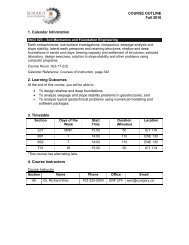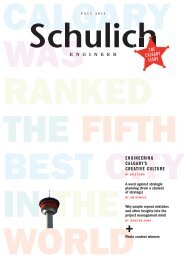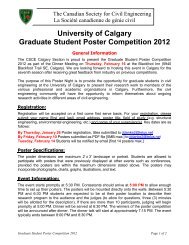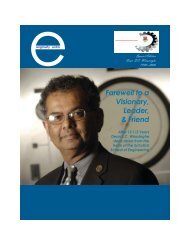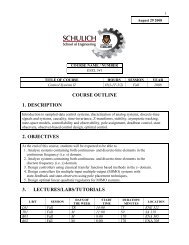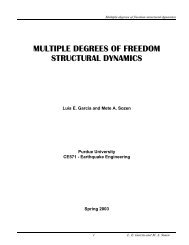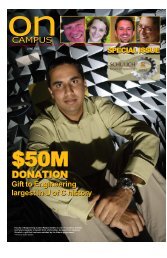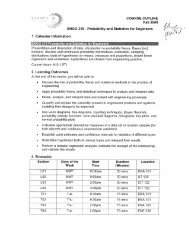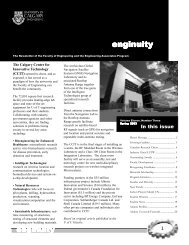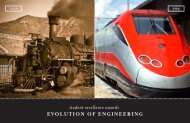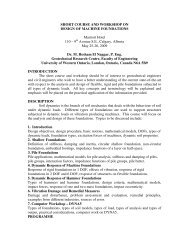high performance - The Schulich School of Engineering - University ...
high performance - The Schulich School of Engineering - University ...
high performance - The Schulich School of Engineering - University ...
- No tags were found...
You also want an ePaper? Increase the reach of your titles
YUMPU automatically turns print PDFs into web optimized ePapers that Google loves.
In the opinion <strong>of</strong> several leading biomedicalengineering researchers, the currentemphasis on <strong>high</strong> <strong>performance</strong> in the fieldcan be linked to some defining characteristicsthat set engineers apart from scientists andmedical practitioners.Janet Ronsky, a <strong>Schulich</strong> <strong>School</strong> <strong>of</strong><strong>Engineering</strong> pr<strong>of</strong>essor <strong>of</strong> mechanical andmanufacturing engineering and CanadaResearch Chair in Biomedical <strong>Engineering</strong>,specifically contrasts the approach <strong>of</strong> medicaldoctors with that <strong>of</strong> engineers.Doctors are trained to look for patternsthat fit a diagnosis. “<strong>The</strong>ir creativity isin detecting what you’ve got. After that,the solution is pretty well prescribed.For engineers, however, there are a wholebunch <strong>of</strong> possible solutions to any problem,”Ronsky says.A complementary view is expressed byMichael Buschmann, a pr<strong>of</strong>essor in theÉcole Polytechnique’s department <strong>of</strong>chemical engineering and Canada ResearchChair in Cartilage Tissue <strong>Engineering</strong>.Molly Shoichet is looking for ways tostimulate stem cells to begin repairs afterspinal column injuries or strokes.Photo by Darryl Augustine“Engineers love to use numbers. <strong>The</strong>yfavour a quantitative approach,” he says.And while engineers embrace the scientificpoint <strong>of</strong> view known as a priori knowledgethey “typically want to solve problems,not just understand something.”U <strong>of</strong> T researcher Molly Shoichet, apr<strong>of</strong>essor in the department <strong>of</strong> chemicalengineering and applied chemistryand Canada Research Chair in Tissue<strong>Engineering</strong>, notes that a decade ag<strong>of</strong>ew engineering students were eventaught biology.“Yet today we can think about not simplyimplanting a device for every specificfunction but about actually overcomingthe very disease itself through biomedicalengineering,” she says.In addition, a special kind <strong>of</strong> engineer isattracted to biomedical engineering, saysRonsky. “<strong>The</strong> field tends to capture peoplewhose imagination is turned on by theadditional layer <strong>of</strong> complexity when youadd a biological system to the standardengineering areas.”Ronsky’s long-term research provides anexample <strong>of</strong> just such complexity. Since1998 she’s been leading a project toimprove the diagnosis and treatment <strong>of</strong>S-shaped curvature <strong>of</strong> the spine (scoliosis)in youth. <strong>The</strong> research has produceda 3-D reconstruction <strong>of</strong> the torsoderived primarily from two-dimensionalphotographs captured with four cameras.This technique lets doctors track theprogression <strong>of</strong> the affliction withoutrelying on twice-yearly heavy doses <strong>of</strong>X-rays, with their heightened potential forharm during puberty.As well, Ronsky’s team has marriedgeomatics with the photographic techniqueso the technicians who fashion braces forspinal scoliosis can now work from a detailedmathematical model <strong>of</strong> an individual’storso on a computer monitor. Once theyhave designed a brace that best matchesthe 300,000 points defining that specifictorso, fabrication instructions are sent toa computer numerical controlled (CNC)milling machine which produces a full-scaleversion, exact in every detail.“We can now start applying some science towhat’s working in the design <strong>of</strong> the bracesand what’s not working,” says Ronsky.She estimates that the customized bracemakingis three to four years away fromcommercial application. That’s smack-dabin the middle <strong>of</strong> the two-to-seven year timeframe that is the mantra for the newestCanadian initiative in this burgeoningfield – a national biomedical engineeringinnovation centre announced in 2008 byU <strong>of</strong> C President Harvey Weingarten in hisannual Report to the Community.<strong>The</strong> Biovantage Alberta Ingenuity Centreat the <strong>University</strong> <strong>of</strong> Calgary will provide anational focus on moving the promisingproducts <strong>of</strong> biomedical engineeringto market – a priority <strong>of</strong> the federalS&T strategy – by bringing togethercommercialization experts with researchersfrom the university, government andprivate sectors. It will be “very much runlike a business,” says Ronsky, who is theinaugural director.A technological showpiece <strong>of</strong> the centreis a unique suite <strong>of</strong> test instruments forbiomaterials and tissue engineering thatare being custom built by the ElectroForceSystems Group <strong>of</strong> the Bose Corporation,better known to consumers for <strong>high</strong>-endaudio components. <strong>The</strong> instruments aredriven by a Bose-designed linear motorthat provides leading-edge fidelity.<strong>The</strong> centre at the <strong>University</strong><strong>of</strong> Calgary will provide anational focus on movingthe promising products<strong>of</strong> biomedical engineeringto market – a priority <strong>of</strong>the federal S&T strategy– by bringing togethercommercialization expertswith researchers from theuniversity, governmentand private sectors. It willbe “very much run like abusiness,” says Ronsky, whois the inaugural director.Ronsky says the test instruments willallow centre researchers to preciselymeasure how much deformation iscaused when any given force is appliedto everything from a stretch <strong>of</strong> skin rightup to ligaments attached to bones. <strong>The</strong>instruments can be run through repetitivecycles which would simulate the effectson ligaments <strong>of</strong> walking, for example.That’s not all that sets the new centreapart from more conventional researchfacilities, even those incorporating socalledbusiness “incubators.” While thecentre will not hire new faculty, it willfund “innovators in residence” who arepursuing projects with commercializationprospects within that two-to-seven yeartime frame. <strong>The</strong>se could be people fromthe <strong>University</strong> <strong>of</strong> Calgary, other academicinstitutions, industry or “anywhere inthe world” says Ronsky.“<strong>The</strong>re’s a world-wide shortage <strong>of</strong> peopletrained in biomedical engineering andwith entrepreneurial skills.”Moving the bright ideas <strong>of</strong> universityresearch to market has long been seen asa problem by policy-makers. In the early1970s, the Science Council <strong>of</strong> Canadadefined the issue in a landmark studyentitled “Innovation in a Cold Climate.”An innovation report earlier this year fromthe Council <strong>of</strong> Canadian Academies foundthat little had changed in three decades.Ronsky says there are three reasons thenew centre should make a difference.It will:• provide a venue and a capacity specificallydesigned to make commercializationhappen;• allow researchers to take part at their“comfort” level, from handing their ideaover to others for commercialization totaking it all the way to market themselves;• give industry a mechanism for partneringwith academic research and gaining accessto specific problem-solving expertise oreven clinical trials.With more than 100 researchers alreadyworking in biomedical engineeringresearch at <strong>Schulich</strong> and across thecampus, Biovantage already has its eyeon some projects that could even becalled “shovel-ready,” such as the imagingtechnology developed in Ronsky’s spinalscoliosis project.Also close to marketability, accordingto <strong>Schulich</strong>’s Carolyn Anglin, is acomputer-assisted system to help surgeonshorizontally slice the patella or kneecapmore accurately, an essential step in kneereplacement operations.Patellar cuts that are tilted rather thanflat are thought to be an important factorin the post-operative pain experiencedby as many as one in four knee surgerypatients. >>SCHULICH30 ENGINEERSCHULICH 31 ENGINEER



